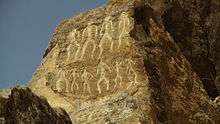Shaddadids
| Shaddadids | |||||
| |||||
 Shaddadid territories during their rule in Ani, 1072–1174. | |||||
| Capital | Dvin, Janza,[1] Ani | ||||
| Government | Emirate | ||||
| Historical era | Middle Ages | ||||
| • | Established | 951 | |||
| • | Disestablished | 1174 | |||
| Today part of | |||||
The Shaddadids were a dynasty of Kurdish origin[2][3][4][5] who ruled in various parts of Armenia and Arran from 951 to 1174 AD. They were established in Dvin. Through their long tenure in Armenia, they often intermarried with the Bagratuni royal family of Armenia.
They began ruling in the city of Dvin, and eventually ruled other major cities, such as Bardha'a and Ganja. A cadet line of the Shaddadids were given the cities of Ani and Tbilisi[6] as a reward for their service to the Seljuqs, to whom they became vassals.[7][8] From 1047 to 1057, the Shaddadids were engaged in several wars against the Byzantine army. The area between the rivers Kura and Arax was ruled by a Shaddadid dynasty.
Part of a series on the |
|---|
| History of Azerbaijan |
 |
|
Early modern history |
|
|
History
In 951, Muhammad bin Shaddadid established himself at Dvin. Unable to hold Dvin against Musafirid incursion, he fled to the Armenian Kingdom of Vaspurakan. His son, Ali Lashkari bin Muhammad, ended Musafirid influence in Arran by taking Ganja in 971. He later expanded into Transcaucasia as far north as Shamkur and as far east as Bardha'a. The reign of his brother, Marzuban bin Muhammad, also lasted only a few years.
Muhammad bin Shaddadid's third son, al-Fadl I ibn Muhammad, expanded his territory during his lengthy reign. He took Dvin from Armenian Bagratids in 1022, and his campaigns against them met with varying degrees of success. He also raided the Khazars in 1030, while holding parts of Azerbaijan.[9] Later that year, while returning from a successful campaign in Georgia, his army encountered Georgian and Armenian forces and was decisively defeated.
Following al-Fadl I's defeat, the entire region became chaotic, with the Byzantine Empire pressuring Armenian princes and the Seljuq Turks gaining influence over Azerbaijan after a Seljuq attack on Dvin. The poet Qatran Tabrizi praised Ali II Lashkari for his victory over Armenian and Georgian princes during his stay in Ganja. Abu'l-Aswar Shavur I ibn al-Fadl I took power in 1049 with Ganja as his capital. He was the last independent ruling Shaddadid until 1067, when Tugrul I arrived at Ganja and demanded his vassalage. With this, the Seljuqs imposed direct rule over Arran and ended Shaddadid influence there.
As their influence continued to decline, Abu'l-Aswar's son, al-Fadl II ibn Shavur I, was captured by the Georgians, and in 1075 Alp Arslan annexed the last of the Shaddadid territories. A cadet branch of Shaddadids continued to rule in Ani and Tbilisi[10] as vassals of the Great Seljuq Empire until 1175, when Malik-Shah I deposed al-Fadl III.[11][12]
Shaddadid rulers
Emirs in Dvin and Ganja
- Muhammad b. Shaddad (951–54)
- Lashkari I b. Muhammad (971–78)
- Marzuban b. Muhammad (978–85)
- Fadl I b. Muhammad (985–1031)
- Musa b. Fadl (1031–34)
- Lashkari II b. Musa (1034–49)
- Anushirvan b. Lashkari (1049)
- Abu'l-Aswar Shavur I b. Fadl (1049–67)
- Fadl II b. Shavur (1067–73)
- Ashot b. Shavur (1068–69)
- Fadl III b. Fadl (1073–75)
Emirs in Ani

- Manuchihr b. Shavur (1072–1118)
- Abu'l-Aswar Shavur II (1118–24)
- Fadl IV b. Shavur (1125–?)
- Mahmud b. Shavur (?–1131)
- Khushchikr (1131–?)
- Shaddad b. Mahmud (?–1155)
- Fadl V b. Mahmud (1155–61)
- Shahanshah b. Mahmud (1164–74)
- Sultan b. Mahmud (?–ca. 1198/9)
See also
- List of Sunni Muslim dynasties
- [[List of Kurdish dynasties and countries]
Notes
- ↑ Andrew C. S. Peacock, Nomadic Society and the Seljūq Campaigns in Caucasia, Iran & the Caucasus, Vol. 9, No. 2, 2005:210.
- ↑ Hugh Kennedy, The Prophet and the Age of the Caliphates The Kurdish dynasties which emerged in the second half of tenth century...Shaddadids of Azerbayjan
- ↑ Andrew C. S. Peacock, Nomadic Society and the Seljūq Campaigns in Caucasia, 209.
- ↑ Shaddadids, C.E. Bosworth, The Encyclopedia of Islam, Vol.IX, Ed. C.E.Bosworth, E. van Donzel, W.P.Heinrichs and G.Lecomte, (Brill, 1997), 169.
- ↑ Lokman I. Meho,Kelly L. Maglaughli (1968). Kurdish culture and society: an annotated bibliography. Greenwood Publishing Group. ISBN 978-0-313-31543-5.
- ↑ Caucasica in the History of Mayyāfāriqīn, V. Minorsky, Bulletin of the School of Oriental and African Studies, Vol.13, No.1, 1949, Cambridge University Press, 29.
- ↑ Shaddadids, C.E. Bosworth, The Encyclopedia of Islam, Vol.IX, 169.
- ↑ Andrew C. S. Peacock, Nomadic Society and the Seljūq Campaigns in Caucasia, 216.
- ↑ Shabankara, C.E. Bosworth and V.F.Buchner, The Encyclopedia of Islam, Vol.IX, Ed. C.E.Bosworth, E. van Donzel, W.P.Heinrichs and G.Lecomte, (Brill, 1997), 157.
- ↑ Caucasica in the History of Mayyāfāriqīn, V. Minorsky, 29.
- ↑ Surveyor versus Epigrapher, Sheila S. Blair, Muqarnas, Vol. 8, 1991, Brill, 68.
- ↑ Shaddadids, C.E. Bosworth, The Encyclopedia of Islam, Vol.IX, 170.
References
- Diplomacy gone to seed: a history of Byzantine foreign relations, A.D. 1047-57, By Paul A. Blaum, International Journal of Kurdish Studies, Jan. 2005.
- Kurds, from Home of Tour Armenia
- A Chronology of World Political History (801 - 1000 C.E.)
- Arran, By: C. E. Bosworth, From Encyclopaedia Iranica, page 522.
- The Caucasus (Contains a list of the early Shaddadid Kings)
- Minorsky, Vladimir (1953). Studies in Caucasian History. New York: Taylor’s Foreign Press. ISBN 0-521-05735-3.
- Shaddadid Coinage at forumancientcoins.com